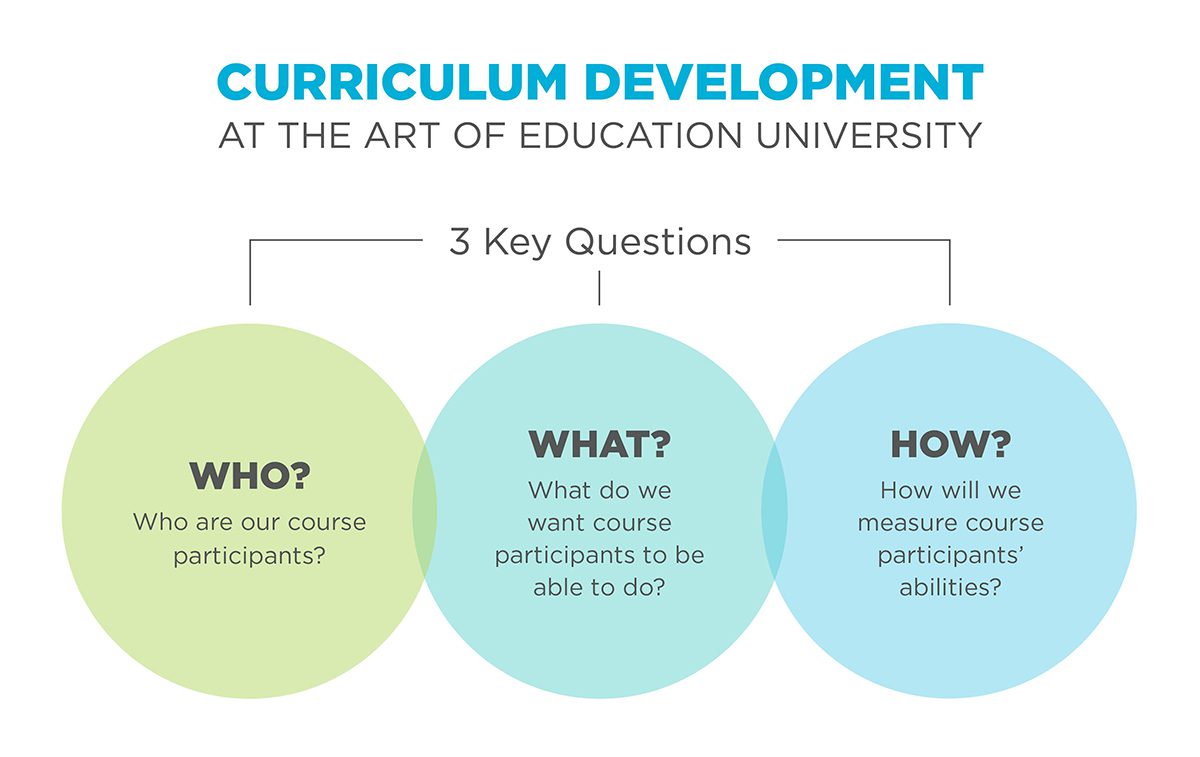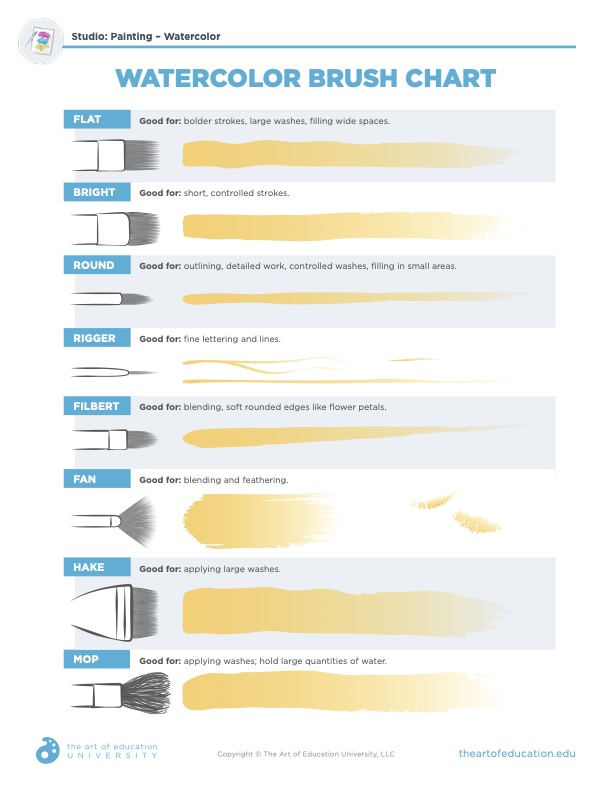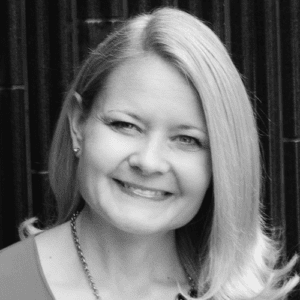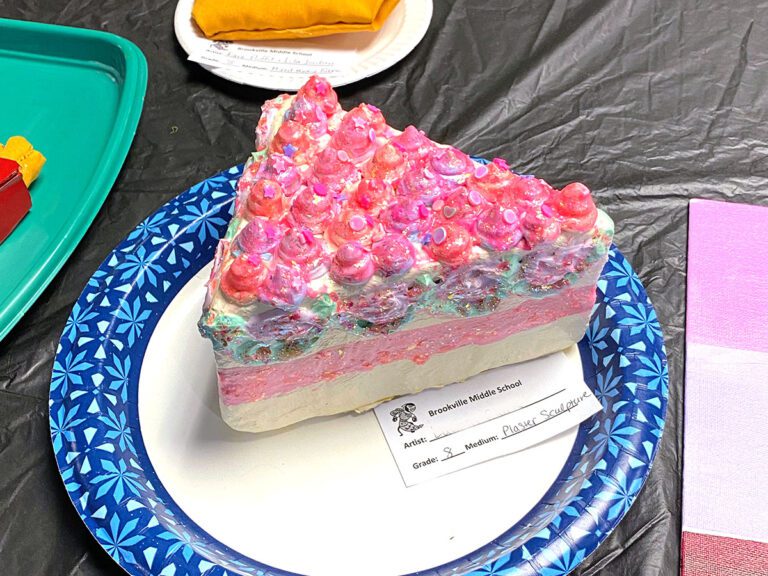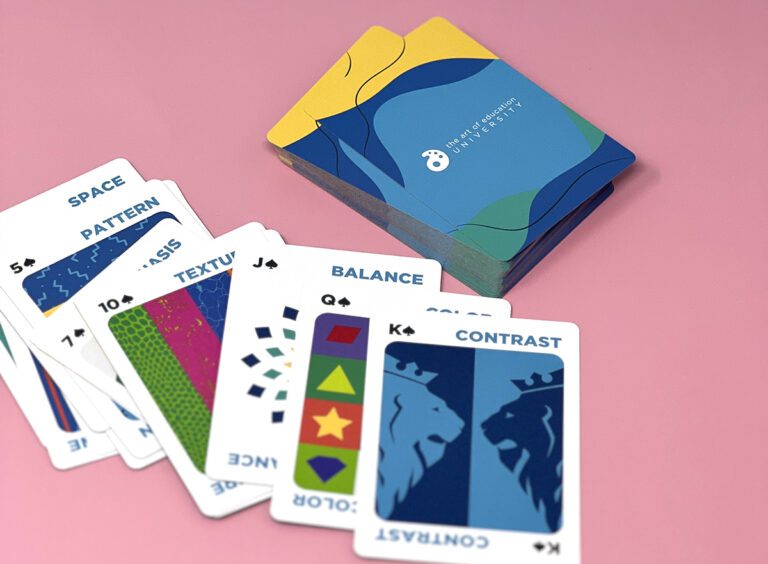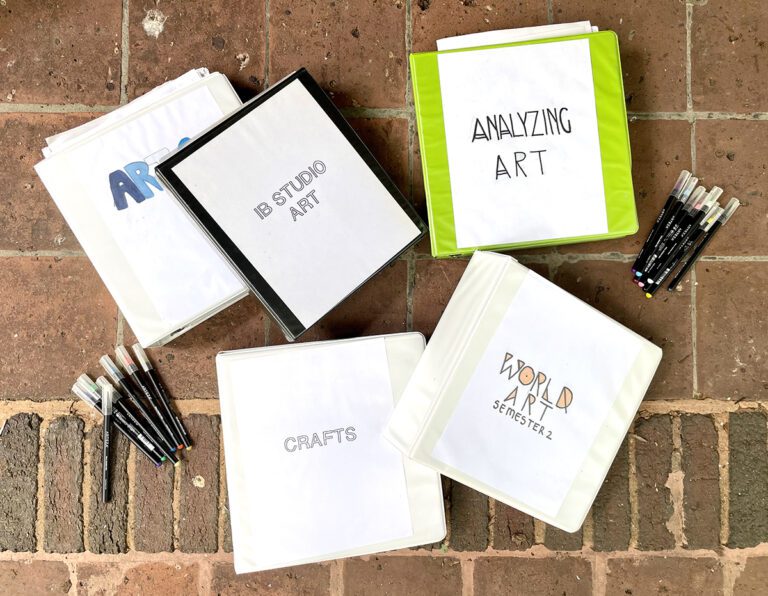Many art teachers approach online courses with a sense of caution. You sign up, hoping for relevant content, planned by experts, and executed by enthusiastic facilitators. But, more often than not, you walk away unfulfilled. That is frustrating!
Luckily, irrelevant, outdated content is something you never have to worry about at The Art of Education University. AOEU content is developed by art teachers for art teachers.
When you sign up for a course with AOEU, rest assured you are getting the best course content for art teachers. As AOEU’s Chief Academic Officer and Head of Curriculum, nothing could be more important to me.
Let’s look at how AOEU designs and revises courses to continually bring you the best practices in art education.

When searching for online courses, it is important to know how the content is developed and vetted. At AOEU, you can rest assured your learning and development is in excellent hands.
Here are 5 reasons to trust your online learning to AOEU.
AOEU courses are…
- Built to include the most up-to-date best practices in art education.
- Written by passionate and talented experts in art education.
- Vetted by a team of art education professionals.
- Monitored closely during release and adjusted and improved as needed.
- Reviewed and revised on a regular schedule.
As you can see, we take course development extremely seriously. Let’s take a closer look at how AOEU courses are designed and revised.
Course Design at AOEU
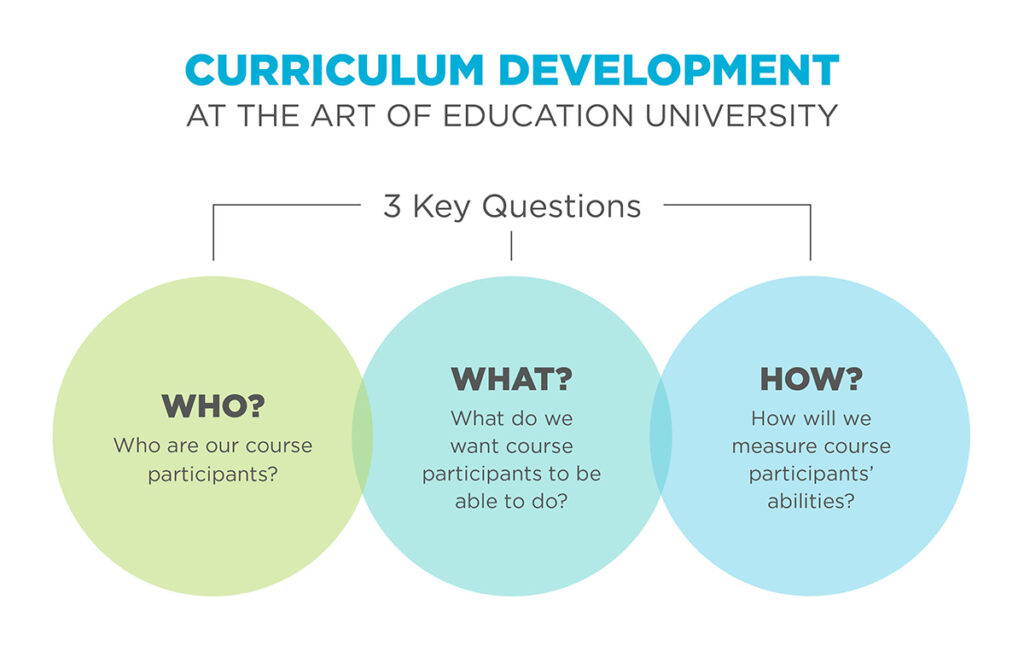
At The Art of Education University, we practice a robust and ever-evolving curriculum development process. With nods to various philosophies, particularly, the ADDIE Model of Instructional Design, our curriculum development cycle involves careful Analysis, Design, Development, Implementation, and Evaluation. The ebb and flow of AOEU’s course development process is visually illustrated in a development flow chart.
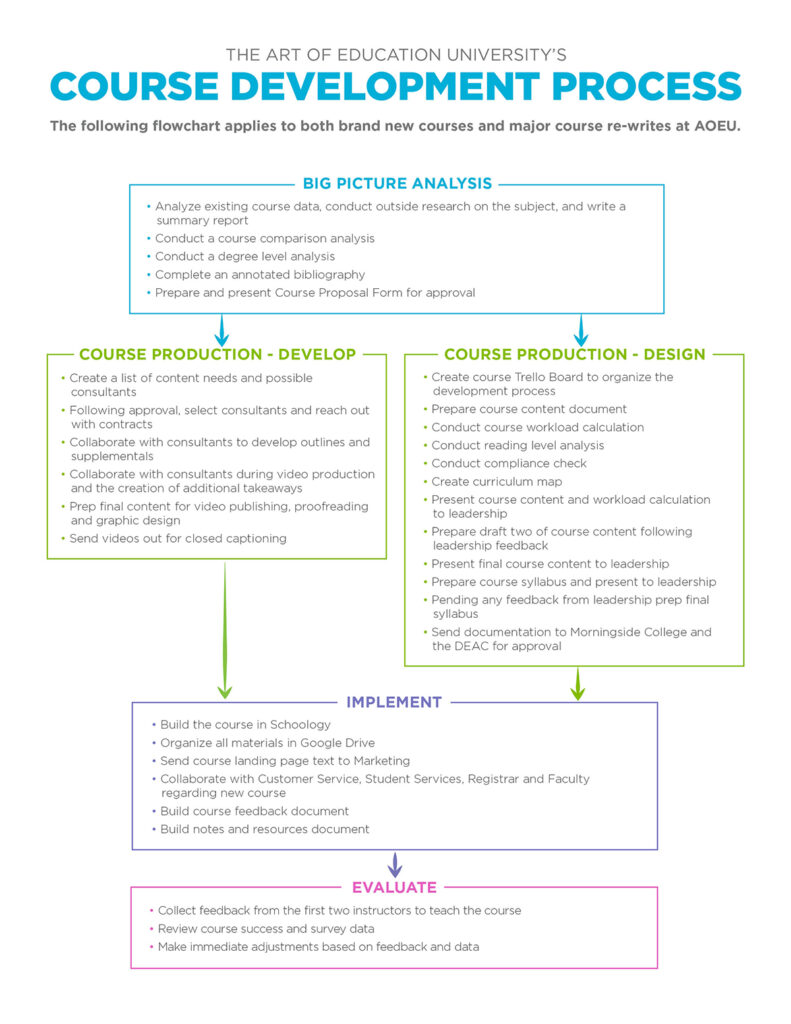
Step 1: Analysis
At the beginning of any course project, curriculum designers conduct a lot of research. If they are revising an existing course, they look at course feedback from instructors and students. They look closely at the content. What remains timeless? What is no longer relevant? If designing a brand new course, designers look beyond AOEU to see what is it that art teachers need concerning a particular topic of interest.
Step 2: Design
During this step, curriculum designers begin writing the actual course. We use a variety of digital tools to stay organized and communicate with one another. Curriculum development isn’t a solo act at AOEU! Curriculum designers collaborate with AOEU leaders and external experts to ensure they are designing the best possible course.
Step 3: Development
This step often occurs in tandem with the design phase. Here, curriculum designers identify subject matter experts and collaborate to produce instructional materials for each class. Instructional materials include videos, demonstrations, handouts, interviews, case studies, and more. As curriculum designers work on these exciting supplements, they continue to revisit the course design at large to assess workflow and workload.
Step 4: Implementation
During this step, curriculum designers build the course content in our LMS platform as they eagerly prepare for the initial course launch. Course materials are linked and tested for accuracy, as we also make plans to share our new or revised course with our audience – YOU!
Step 5: Evaluation
After the first run of a new or revised class, curriculum designers review feedback from its first instructors and students. Needed adjustments are made to ensure the ongoing success of the class.
Let’s peek inside a REAL AOEU course.
AOEU students are busy adult learners juggling a variety of commitments. Therefore, they want course content to be accessible and well-organized. This is why we’ve designed our weekly content much like a to-do list. Our students can work through course resources, supplementals, and assignments in an organized and straightforward way.
For example, here is the main page of our Choice-Based Art Education course.
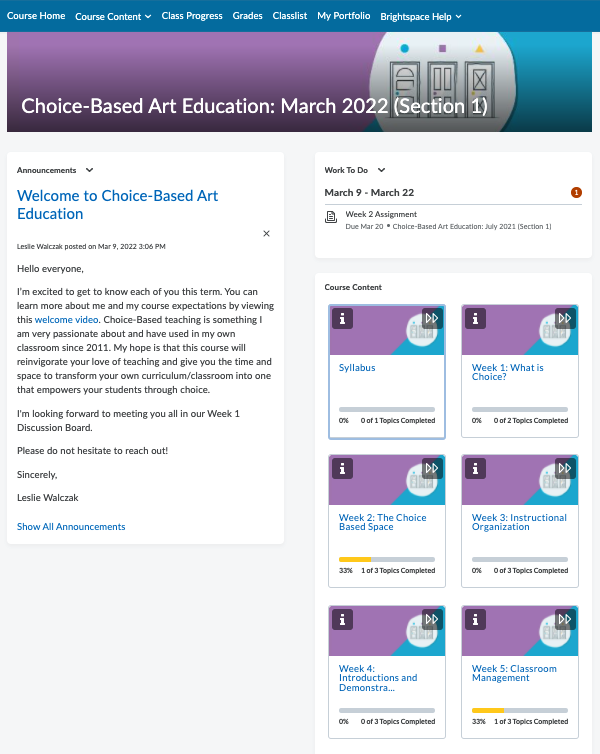
You can see each week is clearly marked with its own content folder. This way, students can work ahead if they so choose. With such flexibility, our students can sign up and feel confident they can fit their coursework in with other commitments and responsibilities.
We design each week to feature a mix of tasks to maintain momentum, while also keeping you engaged. You will find yourself reading articles, viewing videos, creating lesson plans or other tools for your classroom, and more, as you discuss new ideas with peers and instructors.
AOEU is taking online learning to the next level.
Here is another peek inside one of our other offerings, Designing Your Art Curriculum.
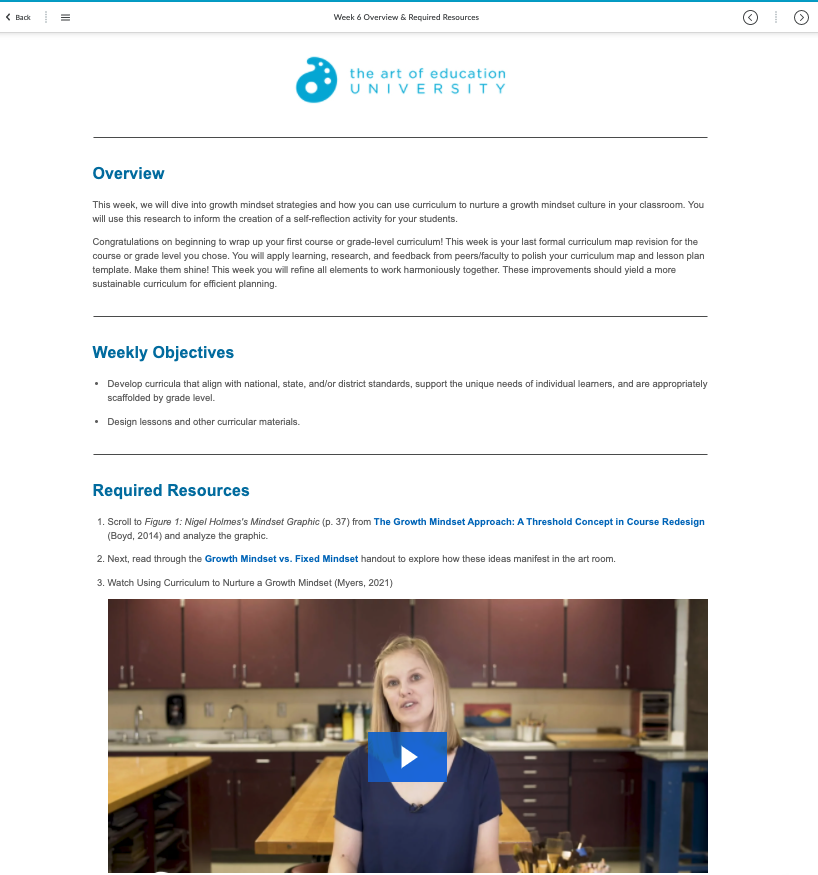
AOEU courses boast a combination of internally created videos and resources, as well as external voices. This is important in fostering a strong learning experience the adult learner can trust and enjoy, while also absorbing a variety of perspectives in the field.
We know as adult learners, you absorb information in a variety of ways. So, presenting demos in video form, providing visually appealing handouts, and facilitating applicable course tasks to YOU and your practice are foundational in our course development at AOEU. Just check out the following preview of our Studio: Watercolor course which boasts helpful video tutorials throughout, as well as beautiful handouts such as this brush chart.
Download Now!
The importance of regular review.
Hopefully, you are thinking to yourself, “The AOEU course development process is not unlike my own process for developing units and lessons for my K-12 art classroom.” That is music to my ears because as a program built by art educators for art educators, we need to practice what we preach. If we are encouraging our adult learners to build courses and programs meaningfully, and review and revise that same content regularly to stay fresh and timely, then we owe it to our students to do the same in the AOEU classroom.
We are developing new courses on a yearly basis. At the same time, we also take our review cycle schedule very seriously.
Existing courses go through a three-tiered process for regular review.
Tier 1
All classes are reviewed and refreshed each month to ensure embedded links are functioning properly and to monitor overall feedback. Base-level data is collected to measure student success and productively. We also convene with our instructors regularly to determine what is working well in the courses.
Tier 2
All classes are formally reviewed annually. During a formal review, curriculum maps are reviewed, and course success data analyzed. AOEU leadership, as well as members of AOEU’s Curriculum Advisory Board Committee, provide important feedback, resulting in more involved course updates as compared to Tier 1. The Curriculum Advisory Board is comprised of experienced leaders in the fields of art education and education respectfully, but not employed by AOEU. This gives us access to expert, outside perspectives regarding our offerings, which inevitably benefit of our learners.
Tier 3
All courses undergo an extensive course review and revision once every three years. During this period, the entire course is analyzed and re-worked as needed, with our adult learners in mind. This review often includes new content development, which means regularly refreshed videos, handouts, and other supplements in your hands as AOEU students!
If it’s been a while since you’ve put your own classroom curriculum through a review process, don’t worry! In AOEU’s Designing Your Art Curriculum course, you will look deeply at a variety of curricular approaches in the field of art. Then, you’ll use your new knowledge to create a personalized curriculum tailored to your students and teaching style.
What does all of this mean for you, the AOEU student?
The Art of Education University thrives on ensuring meaningful professional development is scaffolded for the busy adult learner, and delivered by enthusiastic and experienced practitioners. If you look at AOEU’s courses, rest assured our online classes are prepped by art teachers for art teachers and represent comprehensive and regularly updated perspectives from the field.
So, when do you plan on joining us in the AOEU classroom? We will be ready for you with ridiculously relevant, expertly designed, and regularly improving professional development with none other, but you in mind!
What questions do you still have about course development at AOEU? We’d love to know!
Magazine articles and podcasts are opinions of professional education contributors and do not necessarily represent the position of the Art of Education University (AOEU) or its academic offerings. Contributors use terms in the way they are most often talked about in the scope of their educational experiences.
